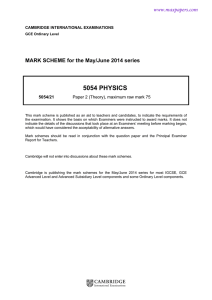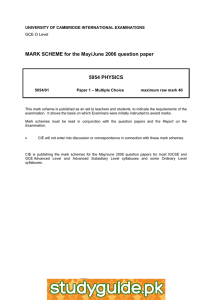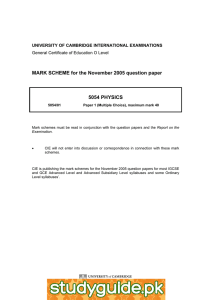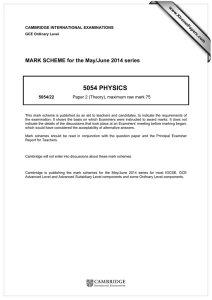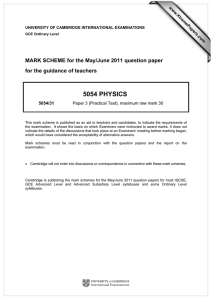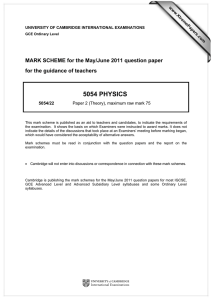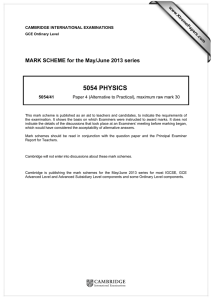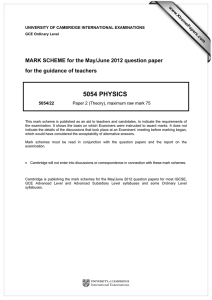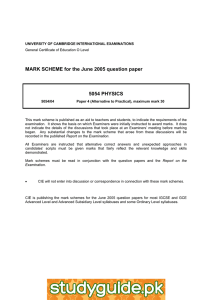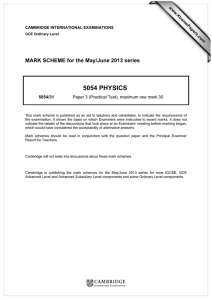5054 PHYSICS MARK SCHEME for the May/June 2014 series
advertisement
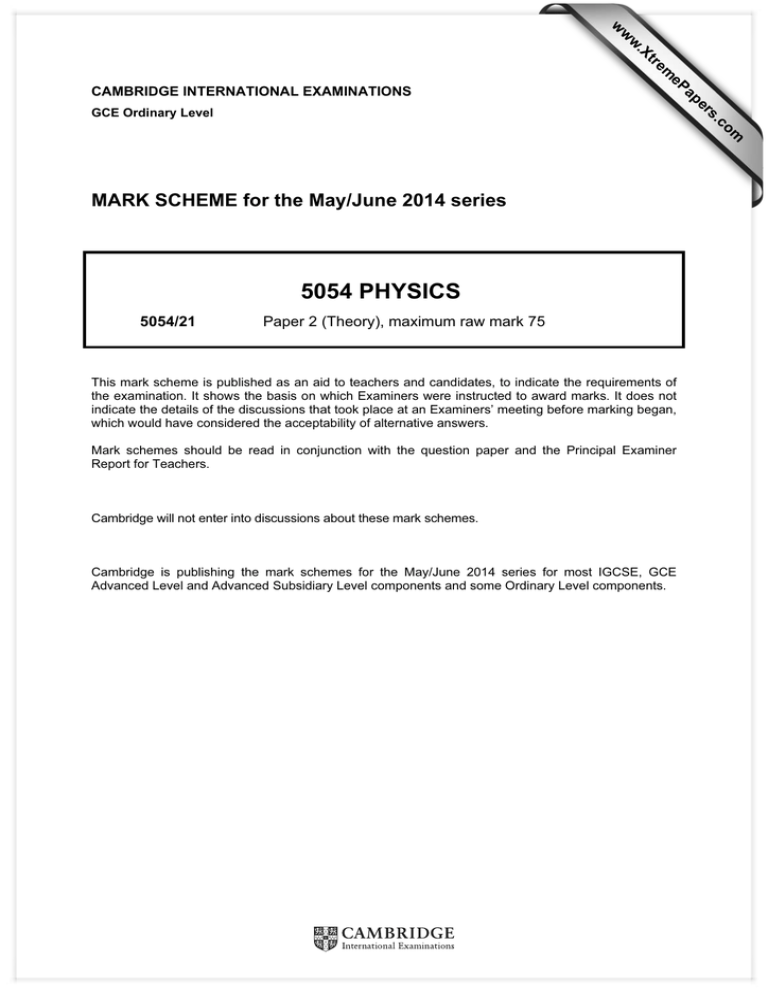
w w ap eP m e tr .X w CAMBRIDGE INTERNATIONAL EXAMINATIONS s er om .c GCE Ordinary Level MARK SCHEME for the May/June 2014 series 5054 PHYSICS 5054/21 Paper 2 (Theory), maximum raw mark 75 This mark scheme is published as an aid to teachers and candidates, to indicate the requirements of the examination. It shows the basis on which Examiners were instructed to award marks. It does not indicate the details of the discussions that took place at an Examiners’ meeting before marking began, which would have considered the acceptability of alternative answers. Mark schemes should be read in conjunction with the question paper and the Principal Examiner Report for Teachers. Cambridge will not enter into discussions about these mark schemes. Cambridge is publishing the mark schemes for the May/June 2014 series for most IGCSE, GCE Advanced Level and Advanced Subsidiary Level components and some Ordinary Level components. Page 2 Mark Scheme GCE O LEVEL – May/June 2014 Syllabus 5054 Paper 21 Section A 1 (a) speed and direction or (change in) distance per sec / unit time + direction or (change in) displacement per sec / unit time (b) two vectors at 45° and one twice the other by eye or labelled 2 (m / s) and 4 (m / s) correct resultant shown for two labelled vectors at any angle with directions shown resultant speed 5.6 ± 0.2 m / s unit needed direction (0)15° or N15 °E, etc. or any clear direction expressed or angle mentioned on answer line and shown on diagram [B1] [B1] [B1] [B1] [B1] [5] 2 (a) current and voltage / p.d. / e.m.f. in correct order [B1] (b) (c=) E / mT in symbols or numbers e.g. 17 000 = 0.85 × c × 22 910 J / (kg °C) [C1] [A1] (c) (i) (hot air) rises or convection mentioned (hot) air less dense [B1] [B1] (ii) lag or cover with insulating material or warmer room or start with colder block [B1] [6] 3 (a) converging or convex [B1] (b) image height ÷ object height [B1] (c) (i) line when extended back joins top of image with intersection of ray and lens [B1] (ii) 3.0 ± 0.1 cm ecf from diagram [B1] (iii) any two further lines from top of stamp that appear to come from the top of the image [B1] [5] © Cambridge International Examinations 2014 Page 3 4 Mark Scheme GCE O LEVEL – May/June 2014 Syllabus 5054 Paper 21 (a) arrow from N to S on at least three lines [B1] (b) magnetic field goes through soft iron or no field through clips paper clips lose their (induced) magnetism [B1] [B1] (c) otherwise beam / electrons / cathode ray / charged particles deviated by magnetic field [B1] [4] 5 (a) equal numbers (5 or less) of negative charges on left and positive charges on right (b) (i) C becomes less positive / less charged U becomes (completely) positive electrons / negative charge flows from U to C or + (on C) and – (on U) cancel / neutralise (ii) like charges repel or both have same charge or both positive [B1] [B1] [B1] [B1] [B1] [5] 6 (a) arrows on long sides in opposite vertical directions downwards on right and upwards on left or correct rotation shown [B1] [B1] (b) no (horizontal) distance between forces or forces through axle / pivot / axis [B1] (c) two halves of split ring clear and clearly connected to each end of coil contacts / brushes labelled or described and connected to battery each side of split ring touches other terminal / brush or current reverses in coil or changes terminals of connection to battery forces reverse on sides of coil or forces always in same direction on side nearest a pole [B1] [B1] [B1] [B1] [7] © Cambridge International Examinations 2014 Page 4 7 (a) Mark Scheme GCE O LEVEL – May/June 2014 A B 6.(0) V 0 (V) Syllabus 5054 (b) (i) resistance (of thermistor) decreases current increases and larger voltage across 2000 Ω / fixed resistor or smaller fraction of voltage across thermistor or potential divider explained (ii) (I =) V / R in symbols or numbers 0.002(0) A; 2 mA Paper 21 [B1, B1] [B1] [B1] [A1] [C1] [6] 8 (a) (i) 53 protons not if also 53 electrons in nucleus 78 neutrons or 131 protons and neutrons (ii) emission of at least one of alpha particle, beta particle or gamma ray emission from the nucleus or breakdown of nucleus (b) (i) random emission indicated (ii) average 2772 or 2773 or 2770 or 2800 or 1 / 8 used or 3 clear halvings seen or (½)3 seen not halving of 131 or 53 value between 330 and 360 [B1] [B1] [B1] [B1] [B1] [C1] [A1] [7] © Cambridge International Examinations 2014 Page 5 Mark Scheme GCE O LEVEL – May/June 2014 Syllabus 5054 Paper 21 SECTION B 9 (a) (i) force per unit area or force divided by area or force on 1 m2 or force on unit area [B1] (ii) more water above or more force from water or more atoms / molecules above [C1] larger weight of water above (iii) Pa or N / m2 [A1] [B1] (b) electrical energy at start of process kinetic energy of water / turbine/blade produced some heat energy / thermal energy / internal energy produce [B1] [B1] [B1] (c) (i) (M=) D × V in any algebraic or numerical form 780 kg [C1] [A1] (ii) (W=) mgh or Fd in any algebraic or numerical form 11700 J or 12000 J [C1] [A1] (iii) (P=) W / t in any algebraic or numerical form or 195(W) 3.25 or 3.2 or 3.3 W [C1] [A1] (d) find difference in mass of container, with and without water measuring cylinder or similar instrument used to find volume and density checked [B1] [B1] other methods are possible, e.g. use of calibrated hydrometer [15] 10 (a) (shortest) distance between two points in phase (b) (i) oscillate or vibrate or move closer and further backwards and forwards or in direction of wave (energy) or longitudinal mentioned (ii) move in opposite directions or when A is on right B is on left (of mean) or A molecules next move apart and B next move together (c) diagram containing sound source (bell / tuning fork, etc.) in container vacuum / pump connected to container remove air sound decreases © Cambridge International Examinations 2014 [B1] [B1] [B1] [B1] [B1] [B1] [M1] [A1] Page 6 Mark Scheme GCE O LEVEL – May/June 2014 Syllabus 5054 Paper 21 (d) (i) sound (that returns) after a reflection [B1] (ii) (s=) d / t in any algebraic or numerical form e.g. 20 (or 40) / 0.12 (or 0.06) 330 or 333 m / s [C1] [A1] (iii) (f=) v / λ in any algebraic or numerical form e.g. 330 / 30 (or 0.03) correct conversion of 30 mm to 0.03 m 11 100 Hz or 11 000 Hz [C1] [C1] [A1] (iv) 0.015 m or 15 mm [B1] [15] 11 (a) (i) work done or energy produced / needed per unit charge or per coulomb (passing through lamp) [M1] [A1] (ii) 1. not straight or curves or gradient changes or data used correctly 2. gets hotter or temperature changes or resistance increases [B1] [B1] (iii) 1. 350 mA or 0.35 A 2. Q = It in any form algebraic or numerical or 2 × 60 × 60 or 7200 (s) seen 2520 C or 2500 C 3. (E=) QV or VIt in any algebraic or numerical form, e.g. 0.35 × 6 × 2 15100 J or 15120 J or 15000 J or 4.2 kWh 4. current and / or voltage falls / varies or some energy remains (in cell) or some energy / heat produced in cell or correct argument involving internal resistance of cell [B1] [C1] [A1] [C1] [A1] (b) lasts longer (because) larger energy (initially) or smaller current (in each cell) or avoids failure if one cell fails (because) other (parallel) cell takes over or larger current / power (in external resistor / lamp) (because) smaller (internal) resistance of combined cells [B1] [M1] [A1] (M1) (A1) (M1) (A1) (c) symbol for LED clear and in correct direction for cells shown 4 cells (not all in parallel or in series), switch and LED (labelled or shown) that switches on and off properly cells connected correctly to give 3.0 V total e.m.f., e.g. two sets of parallel cells connected in series or three in parallel and one in series [B1] [B1] [B1] [15] © Cambridge International Examinations 2014
